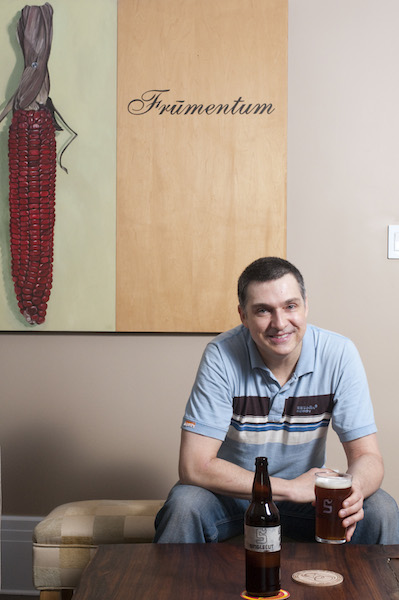Five years ago Rich Buceta probably seemed like the guy who had it all figured out—living on the Upper East Side, commuting to the Flatiron to work as a creative ad exec for DiMassimo Goldstein, producing Web and TV projects for powerhouse clients like AT&T, ESPN, eBay and Sony. But that modern Mad Men life wasn’t fulfilling.
“I hated the business, and the money just wasn’t worth it anymore,” says Buceta. So after 21 years as an ad man, he quit his job in early 2007, determined to find out what he should really do for a living. It turned out that the proper career path was right there in his miniscule Manhattan kitchen: It wasn’t brand names and a big paycheck that made Buceta happy, he found. Instead, it was making beer.
A homebrewer since 2004, Buceta has been known to make five-gallon batches of beer four times a week in his small city pad, despite the space constraints: “I keep everything tucked away in corners at all times,” laughs Buceta. He’s not joking: Brewing kettles and metal kegs lay low beside the couch, where he might perch to use a small grinder to crack malted barley. The windowsill is home not to potted plants but to a row of three wooden aging barrels, which sit snug on their stands as if Buceta’s home were a Belgian mini-monastery. And hidden within a big burgundy-tinted armoire are not suits once worn to client meetings, but meticulously neat rows of bottles filled with his Umlaut Lagrrr!, a crisp, toffee-smooth quaff, or maybe his PNW Mahogany Ale, an almost dank, highly hopped Pacific Northwest–inspired brew with notes of caramel, chocolate and citrus. Those join dozens of potential releases and unnamed test batches, each marked by black-inked labels scribbled in dense longhand on pieces of tape.
But by this fall, with any luck, Buceta will be making all those suds in a much larger space. In September, he plans to open SingleCut Beersmiths in Astoria, which will be the first brewery to open in his home borough since Burke shuttered its Long Island City factory in 1953.
To prepare, Buceta has spent the past five years not just making beer in his bedroom, but learning how to run a brewery. Shortly after he quit his ad job, Buceta, now 48, started sending some of his Upper East Side bottles to a few New York–based breweries as his résumé—this one a lot shorter than the one he compiled working as a creative director. Those self-bottled samples got him hired by Brooklyn’s Greenpoint Beer Works/Kelso of Brooklyn, which produces suds not just for Kelso but also for Manhattan’s Heartland Brewery and a handful of other regional brewers. Buceta’s first job at the Brooklyn brew house was cleaning kegs for
minimal pay. “The beer equivalent,” laughs the man who had been an executive just 18 months prior, “to a dishwasher.”
If the wages and responsibilities were low at first—Buceta was also freelancing for his old ad firm until 2009—the experience was invaluable from the get-go. Greenpoint produces 465,000 to 620,000 gallons a year, and Kelso alone can make 26 types of beers over a given year, including Flemish Red Ale, a hard-to-make, ruby-hued, wood-aged sour, and an Industrial IPA—Buceta’s favorite style—a high-alcohol number that packs a punch of citrus and pine. Soon Buceta wasn’t just cleaning those kegs: Thanks to a combination of what he calls “hard work, position openings and some dumb luck,” Buceta became a brewer after eight months, working side by side with brewmaster Kelly Taylor until last year, when he left to focus on SingleCut.
As if a day job making mash with a master wasn’t enough hands-on experience, Buceta kept up his near-daily homebrewing sessions, too. “I would come home from brewing at work,” says Buceta, “and then brew another five hours in my apartment.” It also gave him a portfolio of more than 50 original recipes—many of them hoppy, a lot of them lagers, the slower-going, harder-to-perfect type of beer Buceta hopes to showcase in Queens. (Beers generally are made in two major categories, based on the type of yeast: ales and lagers, the latter of which require cooler temperatures and work best in specialized fermenting tanks.)
He’s already served a few of those to the public over the past few years when his kitchen became part of the roving “homebrew tours” hosted by beer writer Joshua M. Bernstein. “I was blown away when I first had some of Rich’s beers,” says Bernstein, author of Brewed Awakening: Behind the Beers and Brewers Leading the World’s Craft Brewing Revolution. “He has the ability to create recipes and replicate them, which makes him a true professional,” says Bernstein. “He’s definitely ready.”
By September, Buceta hopes, SingleCut Beersmiths will be, too. Currently in construction at 19-33-37th Street in Astoria, the place will feature a custom-manufactured 30-barrel brew house, including two 60-barrel lagering tanks and, one day, a performance stage to host concerts. (An electric guitar geek and music fan, Buceta named his business after his favorite style of guitar; he’s also in a band.)
While he’s keeping his beer menu under wraps until the brewery opens its doors—not surprisingly for a former creative director, SingleCut’s Web site is beautifully designed and impressively savvy—he will say he hopes to introduce a beer “that pays homage to the proud borough of Queens.” Beyond its own beer, that borough is finally getting its own taste of the local brew scene that’s been fermenting away in other boroughs, mainly in Brooklyn.
“Astoria’s craft beer scene has been a dormant volcano until now,” says Ryan Crook, the founder of Brewstoria, an Astoria-based homebrew club. He adds that he’s ready for Buceta, who for now is commuting from Manhattan, to “bring the movement to where it needs to be.”
We’re betting his Upper East Side landlord feels exactly the same way.
Photo credit: Rebecca McAlpin



